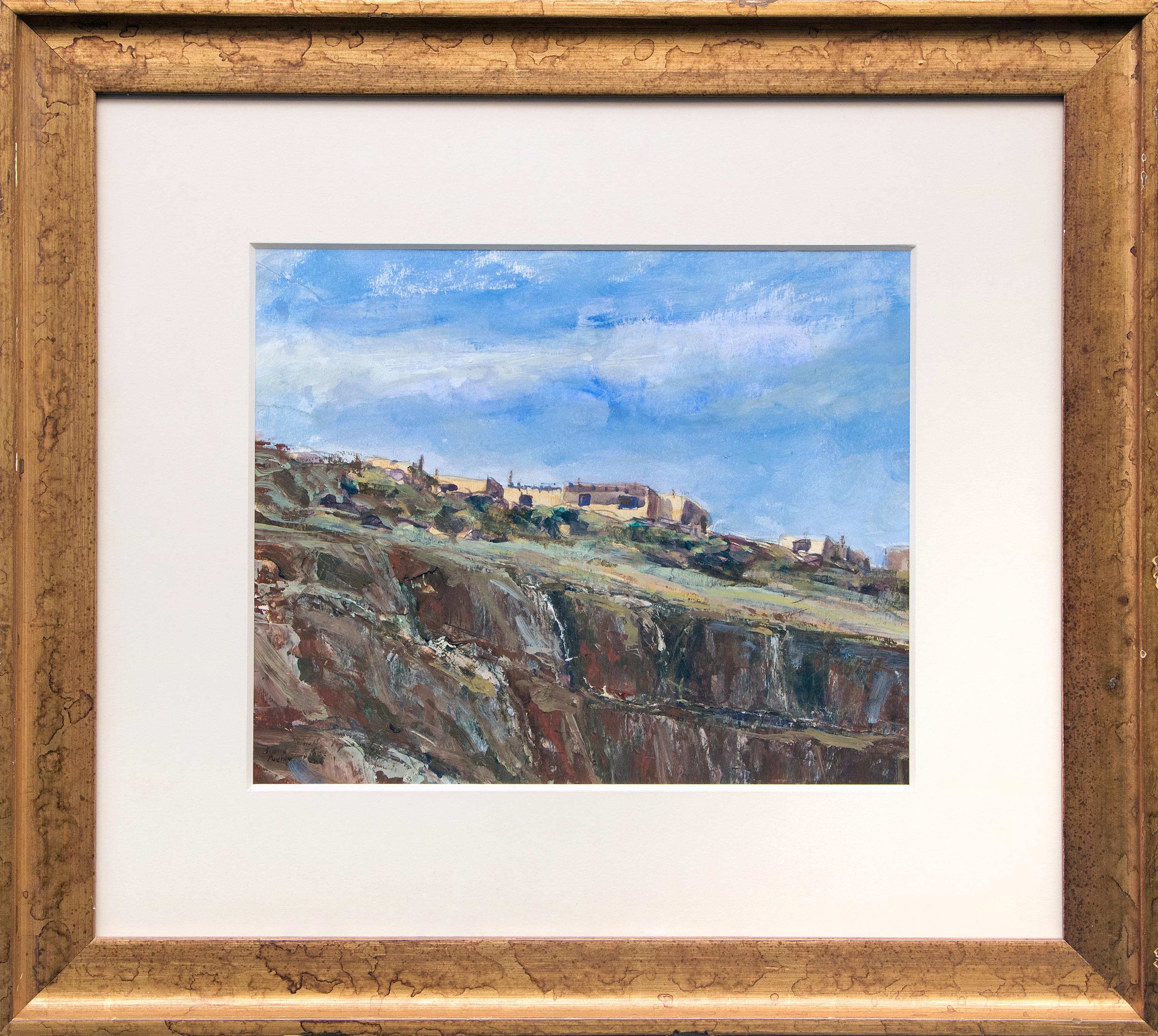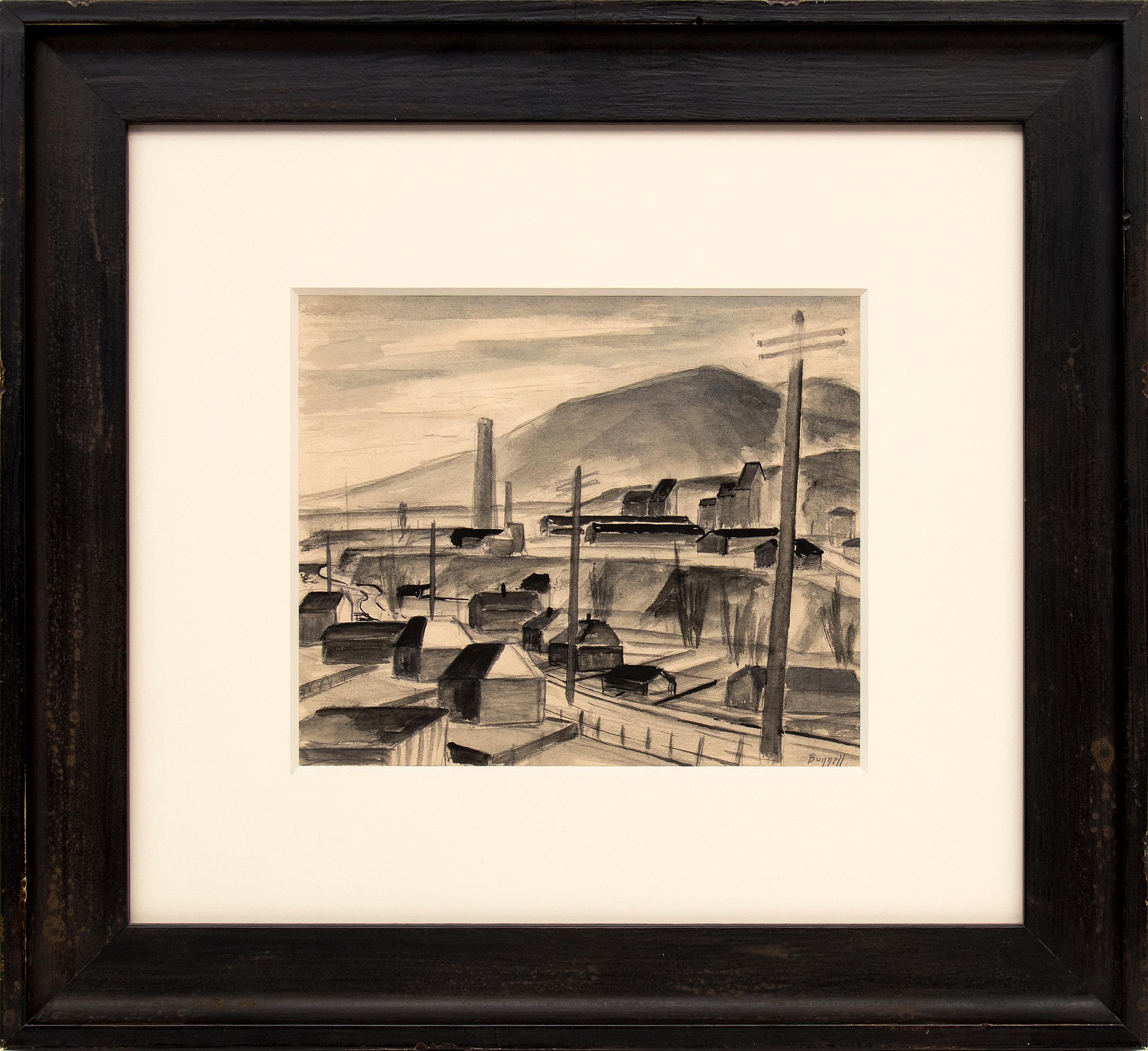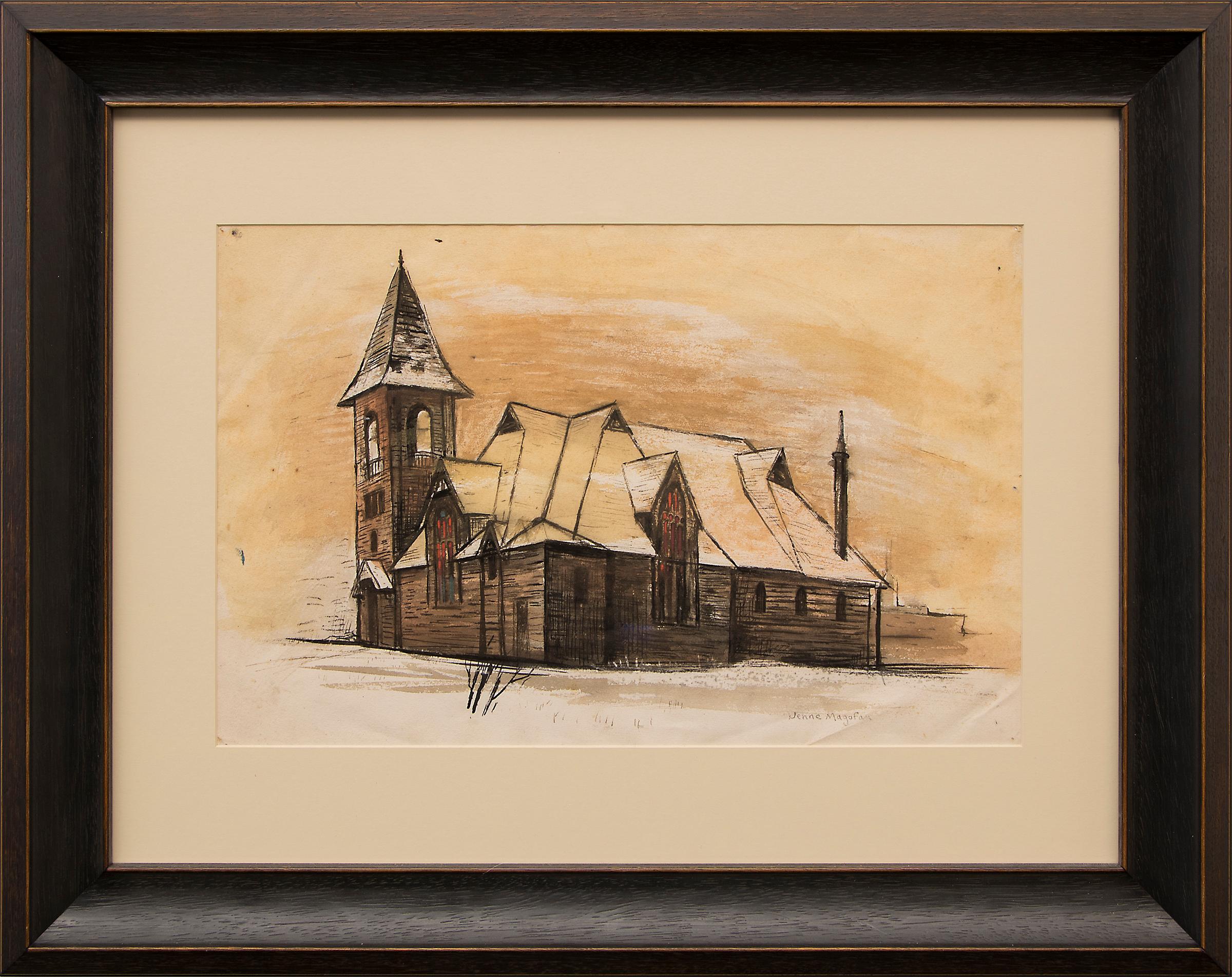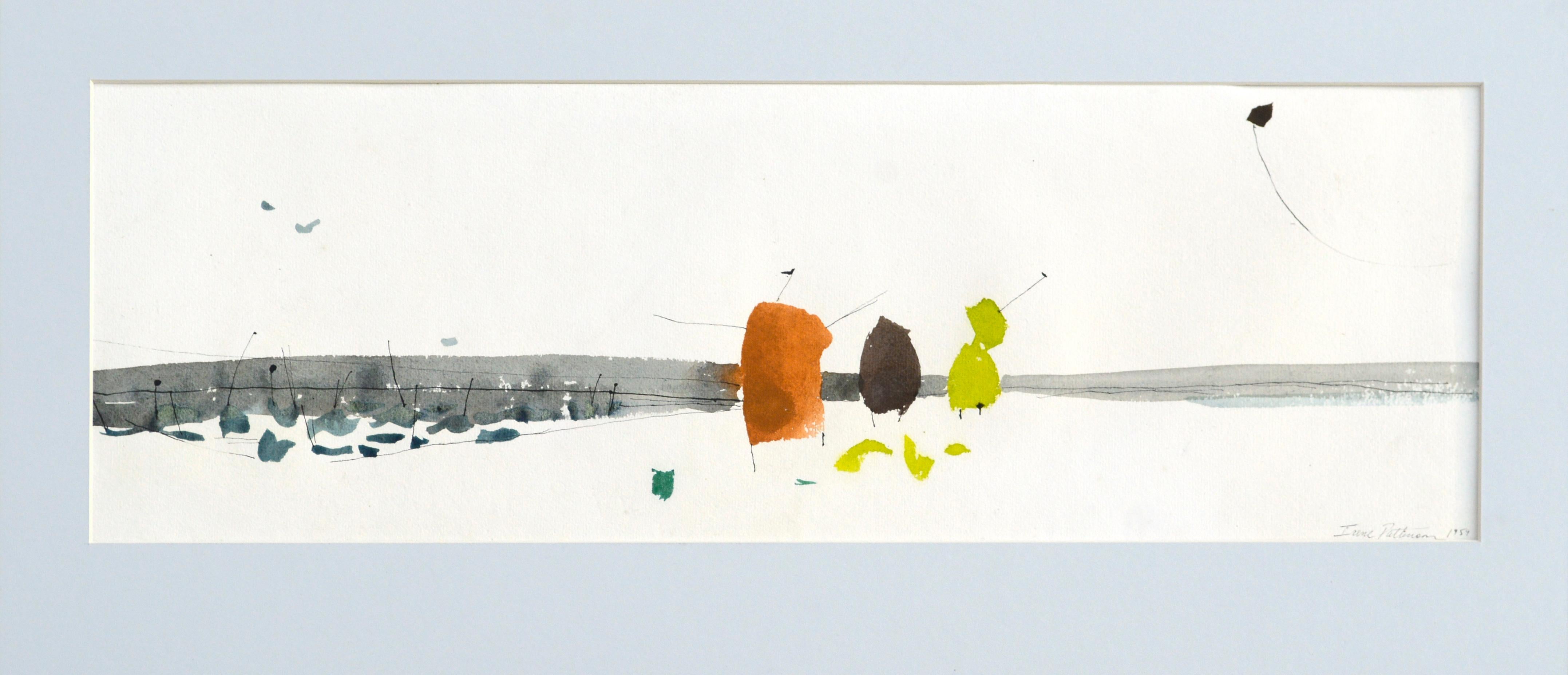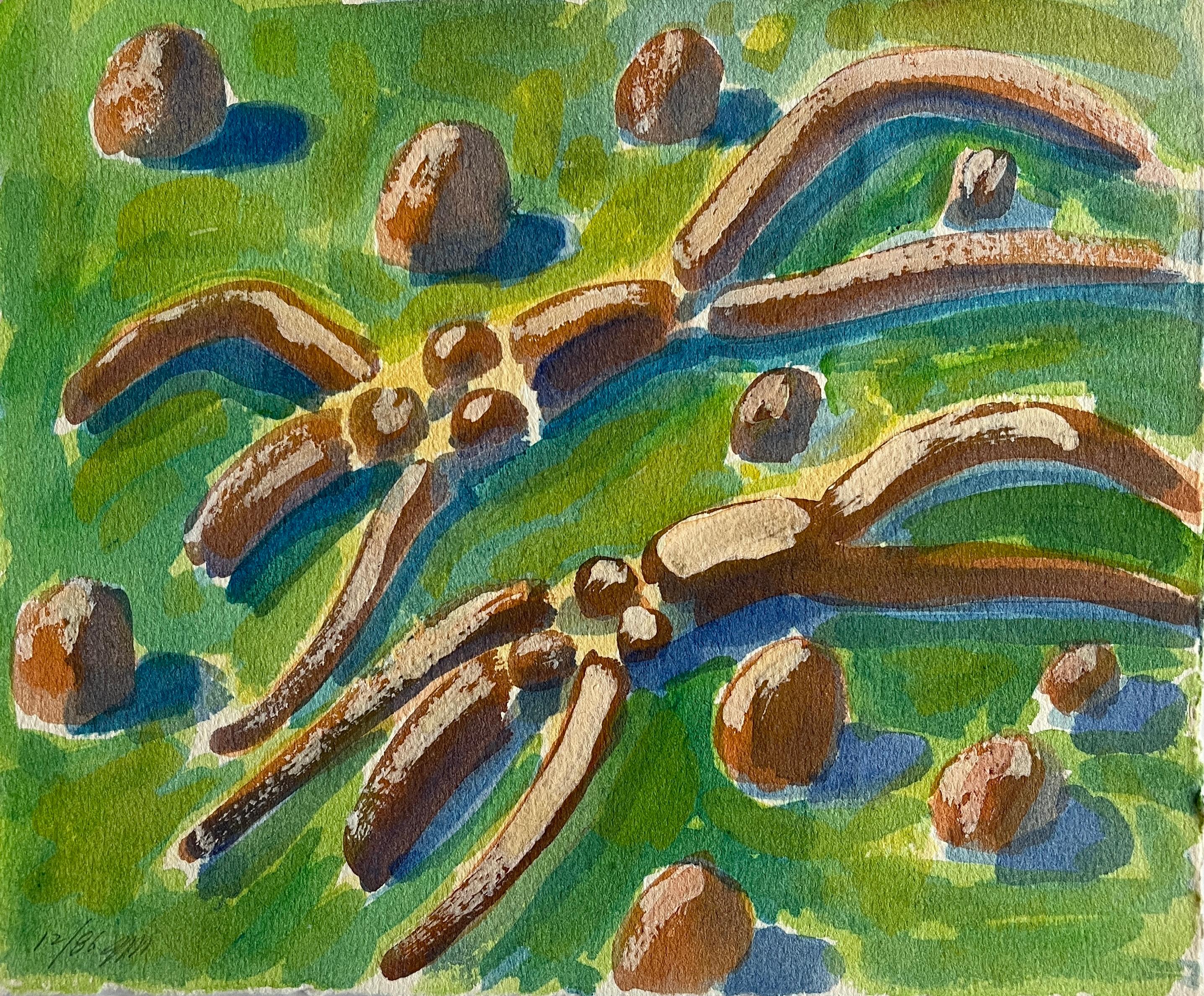Items Similar to Shooting Gallery Mid 20th Century American Scene Social Abstract Realism Modern
Want more images or videos?
Request additional images or videos from the seller
1 of 8
William KienbuschShooting Gallery Mid 20th Century American Scene Social Abstract Realism Modern1941
1941
About the Item
Shooting Gallery Mid 20th Century American Scene Social Abstract Realism Modern
*William Kienbusch (1914 – 1980)
Shooting Gallery, Sixth Avenue
Poster paint on paper, c. 1941
15 ¾ x 21 inches (sight)
18 ¾ x 24 inches (sheet)
Provenance: Kraushaar Galleries.
Please let this letter confirm that the following work came to us directly from the artist's estate:
William Kienbusch (1914 - 1980)
Shooting Gallery, Sixth Avenue, .c 1941
poster paint on paper
image dimensions:
15.75 x 21 inches
40 × 53.3 cm
sheet: 18.75 x 24 inches
and is inscribed on the reverse by the executor of the estate:
William Kienbusch c.1941 OK Stanley Clifford 2/1/83 Clause 32
BIO
William Kienbusch was born in New York City on April 13, 1914. He is a graduate of Princeton University; and knew he wanted to be an artist from his childhood. He studied at the Art Students League, spent a year abroad painting in Paris and then worked with Anton Refregier and Stuart Davis, Henry Varnum Poor and Abraham Ratner. He also painted at Monhegan Island in Maine.
Essentially a landscape painter, he found that reworking nature and translating it into his own terms was the only way to get at its inner meaning and intensity. Kienbusch taught at the Brooklyn Museum Art School.
During World War II, Kienbusch taught camouflage design in the military, and from 1948 to 1969, taught at the Brooklyn Museum School of Art.
Exhibition venues include the Art Institute of Chicago, the Museum of Modern Art and the Whitney Museum of American Art.
- Creator:William Kienbusch (1914 - 1980, American)
- Creation Year:1941
- Dimensions:Height: 23 in (58.42 cm)Width: 28 in (71.12 cm)Depth: 43 in (109.22 cm)
- Medium:
- Movement & Style:
- Period:
- Condition:
- Gallery Location:New York, NY
- Reference Number:1stDibs: LU1156214152452
About the Seller
5.0
Platinum Seller
These expertly vetted sellers are 1stDibs' most experienced sellers and are rated highest by our customers.
Established in 2008
1stDibs seller since 2019
165 sales on 1stDibs
Typical response time: <1 hour
- ShippingRetrieving quote...Ships From: Pawling, NY
- Return PolicyA return for this item may be initiated within 3 days of delivery.
More From This SellerView All
- "NYC Subway" American Modernism Scene WPA Mid-Century Realism Cityscape TransitBy Max Arthur CohnLocated in New York, NY"NYC Subway" American Modernism Scene WPA Mid-Century Realism Cityscape Transit. 26 x 28 inches. Oil on canvas, c. 1940s. Signed lower left. Hand carved frame. Max Arthur Cohn (1903 – 1988) Born in London, England, Cohn became an artist primarily known for scenes of New York City, rural views, and abstract figural compositions. His style has ranged from realism in the 1920s to 1940s to abstraction from the 1950s to 1990s, with some reintroduction in the later years of realism and re-working of earlier subject matter. His primary studio...Category
1940s American Modern Figurative Paintings
MaterialsOil, Canvas
- Waiting for the Bus in a Blizzard- WPA American Scene 1938 NYC Modernism RealismBy Maurice KishLocated in New York, NYWaiting for the Bus in a Blizzard- WPA American Scene 1938 NYC Modernism Realism. 16 x 16 inches, Oil on board, Signed and dated 1938 lower left. ...Category
1930s American Modern Figurative Paintings
MaterialsOil, Board
- "Industrial Cityscape, Chicago" WPA Modernism Mid-Century Cityscape 20th CenturyBy Aaron BohrodLocated in New York, NYMidwestern Chicago artist Aaron Bohrod painted in 1931 this modernist industrial cityscape during the WPA of the 20th Century. Aaron Bohrod (American 1907 – 1992), Industrial Citysc...Category
1930s American Modern Landscape Paintings
MaterialsOil, Board
- "War Brides, Wash Sq NYC" American Scene WWII Modernism WPA Mid-Century OilBy Georgina KlitgaardLocated in New York, NY"War Brides, Wash Sq NYC" American Scene WWII Modernism WPA Mid-Century Oil. 30 x 40 inches. Oil on canvas, c. 1942. Signed lower right. Titled on the stretcher. Housed in a sensational Heydenryk frame. Our gallery, Helicline Fine Art...Category
1940s American Modern Landscape Paintings
MaterialsCanvas, Oil
- "Drama Teacher" 1938 WPA Mid 20th Century American Theatre Surrealism ModernismBy Leon BibelLocated in New York, NY"Drama Teacher" 1938 WPA Mid 20th Century American Theatre Surrealism Modernism. 30 x 24 inches. Oil on Canvas. Signed land dated ’38 lower left. The photograph in the listing depicts the artist's friend who taught drama and about whom the painting is based Painter, printmaker and sculptor, Leon Bibel was born in San Francisco in 1913. He trained at the California School of Fine Arts and received a scholarship to study under the German Impressionist Maria Riedelstein. He worked in collaboration with Bernard Zackheim, a student of Diego Rivera, to create frescoes for the San Francisco Jewish Community Center and the University of California Medical School. In 1936 Bibel moved from California to join the Federal Art Project at Harlem Art...Category
1930s American Modern Figurative Paintings
MaterialsCanvas, Oil
- "Concert" Early 20th Century WPA Modernism American City Landscape Scene AshcanBy Michael LoewLocated in New York, NY"Concert" Early 20th Century WPA Modernism American City Landscape Scene Ashcan The size of the canvas 28 3/4 x 43 1/4 inches. The painting comes directly from the artist's estate. It is signed lower right as well as signed, titled and dated verso. We have available more than two dozen paintings and works on paper from the 1930s - 80s that come directly from the Loew estate. BIO Michael Loew (1907 – 1985) was the son of a New York City baker. After high school, he was an apprentice to a stained-glass maker, and from 1926-1929, he studied at the Art Students League. In 1929, he traveled to Paris, North Africa, Germany, and Italy with a group of artists. When he returned to New York City in 1931, the Great Depression hit Loew unexpectedly, and for the next two years he paid his apartment rent with his paintings. In 1935, he found work with the WPA where he painted murals and partnered up with longtime friend Willem de Kooning in 1939 on a mural for the Hall of Pharmacy at the New York World’s Fair. Their friendship lasted for the rest of their lives. In the mid-30’s he painted in Mexico and the Yucatán documenting the construction of a U.S. Naval airbase on Tinian Island. It was from this airbase that the Enola...Category
1920s American Modern Figurative Paintings
MaterialsCanvas, Oil
You May Also Like
- Acoma Pueblo, New Mexico, 1970s Southwest Landscape Scene Gouache PaintingLocated in Denver, CO"Acoma Pueble (New Mexico) is a gouache on paper painting by Wolfgang Pogzoba (1936-1982) from 1978 of a landscape and an adobe home over a cliff side in the town of Acoma Pueblo, NM. Presented in a custom frame, outer dimensions measure 22 ⅜ x 25 inches. Image size is 12 x 15 inches. The Acoma Pueblo is located approximately 60 miles west of Albuquerque, New Mexico. Painting is clean and in good condition - please contact us for a detailed condition report. Expedited and international shipping is available - please contact us for a quote. About the Artist: Wolfgang Pogzeba...Category
1970s American Modern Landscape Paintings
MaterialsGouache, Paper
- Golden Cycle Mill, Colorado, 1940s WPA Mining Watercolor Landscape, Black WhiteBy Charles Ragland BunnellLocated in Denver, COOriginal 1940s watercolor on paper painting by Charles Ragland Bunnell portraying a semi abstracted view of Golden Cycle Mill in Colorado Springs, Colorado. Painted in shades of black and gray. Presented in a custom black frame, outer dimensions measure 18 x 19 ½ x 1 ⅜ inches. Image sight size is 8 ⅛ x 9 ⅝ inches. Golden Cycle Mining and Reduction Company was a mining company in Colorado City (now Old Colorado City) in El Paso County, Colorado. Piece is clean and in excellent condition - please contact us for a detailed condition report. Expedited and international shipping is available - please contact us for a quote. About the artist: Artist and teacher, Charles (“Charlie”) Bunnell worked in a variety of styles throughout his career because as an artist he believed, “I’ve got to paint a thousand different ways. I don’t paint any one way.” At different times he did representational landscapes while concurrently involved with semi- or completely abstract imagery. He was one of a relatively small number of artists in Colorado successfully incorporating into their work the new trends emanating from New York and Europe after World War II. During his lifetime he generally did not attract a great deal of critical attention from museums, critics and academia. However, he personally experienced a highpoint in his career when Katherine Kuh, curator at the Art Institute of Chicago, personally chose one of his paintings – Why? - for its large exhibition of several hundred examples of abstract and surrealist art held in 1947-48, subsequently including it among the fifty pieces selected for a traveling show to ten other American museums. An only child, Bunnell developed his love of art at a young age through frequent drawing and political cartooning. In high school he was interested in baseball and golf and also was the tennis champion for Westport High School in Kansas City. Following graduation, his father moved the family to Denver, Colorado, in 1916 for a better-paying bookkeeping job, before relocating the following year to Colorado Springs to work for local businessman, Edmond C. van Diest, President of the Western Public Service Company and the Colorado Concrete Company. Bunnell would spend almost all of his adult life in Colorado Springs. In 1918 he enlisted in the United States Army, serving in the 62nd Infantry Regiment through the end of World War I. Returning home with a 10% disability, he joined the Zebulon Pike Post No. 1 of the Disabled American Veterans Association and in 1921 used the benefits from his disability to attend a class in commercial art design conducted under a government program in Colorado Springs. The following year he transferred to the Broadmoor Art Academy (founded in 1919) where he studied with William Potter and in 1923 with Birger Sandzén. Sandzén’s influence is reflected in Bunnell’s untitled Colorado landscape (1925) with a bright blue-rose palette. For several years thereafter Bunnell worked independently until returning to the Broadmoor Art Academy to study in 1927-28 with Ernest Lawson, who previously taught at the Kansas City Art Institute where Bunnell himself later taught in the summers of 1929-1930 and in 1940-41. Lawson, a landscapist and colorist, was known for his early twentieth-century connection with “The Eight” in New York, a group of forward-looking painters including Robert Henri and John Sloan whose subject matter combined a modernist style with urban-based realism. Bunnell, who won first-place awards in Lawson’s landscapes classes at the Academy, was promoted to his assistant instructor for the figure classes in the 1928-29 winter term. Lawson, who painted in what New York critic James Huneker termed a “crushed jewel” technique, enjoyed additional recognition as a member of the Committee on Foreign Exhibits that helped organize the landmark New York Armory Exhibition in 1913 in which Lawson showed and which introduced European avant-garde art to the American public. As noted in his 1964 interview for the Archives of American Art in Washington, DC, Bunnell learned the most about his teacher’s use of color by talking with him about it over Scotch as his assistant instructor. “Believe me,” Bunnell later said, “[Ernie] knew color, one of the few Americans that did.” His association with Lawson resulted in local scenes of Pikes Peak, Eleven Mile Canyon, the Gold Cycle Mine near Colorado City and other similar sites, employing built up pigments that allowed the surfaces of his canvases to shimmer with color and light. (Eleven Mile Canyon was shown in the annual juried show at the Carnegie Institute in Pittsburgh in 1928, an early recognition of his talent outside of Colorado.) At the same time, he animated his scenes of Colorado Springs locales by defining the image shapes with color and line as demonstrated in Contrasts (1929). Included in the Midwestern Artists’ Exhibition in Kansas City in 1929, it earned him the gold medal of the Kansas City Art Institute, auguring his career as a professional artist. In the 1930s Bunnell used the oil, watercolor and lithography media to create a mini-genre of Colorado’s old mining towns and mills, subject matter spurned by many local artists at the time in favor of grand mountain scenery. In contrast to his earlier images, these newer ones – both daytime and nocturnal -- such as Blue Bird Mine essentially are form studies. The conical, square and rectangular shapes of the buildings and other structures are placed in the stark, undulating terrain of the mountains and valleys devoid of any vegetation or human presence. In the mid-1930s he also used the same approach in his monochromatic lithographs titled Evolution, Late Evening, K.C. (Kansas City) and The Mill, continuing it into the next decade with his oil painting, Pikes Peak (1942). During the early 1930s he studied for a time with Boardman Robinson, director of the Broadmoor Art Academy and its successor institution, the Colorado Springs Fine Arts Center from 1930 to 1947. In 1934 Robinson gave him the mural commission under the Public Works of Art Project (PWAP) for West Junior High School in Colorado Springs, his first involvement in one of several New Deal art...Category
1940s American Modern Landscape Paintings
MaterialsPaper, Watercolor
- Church in Leadville, Colorado, 1930s Framed Landscape Watercolor Ink PaintingBy Jenne MagafanLocated in Denver, CORare WPA era original painting by Colorado/Woodstock modernist, Jenne Magafan (1916-1952). Church in Leadville, 1938 is presented in a custom frame with all archival materials, oute...Category
1930s American Modern Landscape Paintings
MaterialsArchival Paper, Watercolor, Archival Ink
- Mid Century Abstracted Landscape -- Flying A Kite at the BeachBy Irene PattinsonLocated in Soquel, CAPlayful abstracted watercolor of a beach scene by Irene Pattinson (American, 1909-1999). Signed and dated "Irene Pattinson 1959" in the lower right corner. Presented in a new French ...Category
1950s American Modern Landscape Paintings
MaterialsWatercolor, Pen, Paper
- Society of Six Street Scene - Figurative AbstractBy Bernard Von EichmanLocated in Soquel, CAStunning New York City urban modernist watercolor titled "Summer Afternoon Stroll" by Society of Six artist Bernard Von Eichman (American, 1899-1990), 1...Category
1930s American Modern Landscape Paintings
MaterialsArchival Paper, Watercolor
- "Figures Laying with Shadows" 1986 American Modernist Jack Hooper PaintingBy Jack HooperLocated in Arp, TXJack Hooper "Figures Laying with Shadows" December 1986 Paint on paper 9.5"x8" unframed Signed and dated in pencil lower left In this modernist masterpiece by Jack Hooper, two abstr...Category
1980s American Modern Figurative Paintings
MaterialsPaint, Paper
Recently Viewed
View AllMore Ways To Browse
World War Ii American
Shooting Gallery
Vintage Childhood
An American In Paris Poster
Chicago Mid Modern
Poster New York Gallery
20th Century Realism Art
Shooting Scenes
18c American
Brooklyn Scene Paintings
Reverse Painted Scene
Paris Gallery Poster
Chicago Estate
World War 2 Paint
20th Century Modern Realism
20th Century American Realism
Maine Island
Islands In Maine
